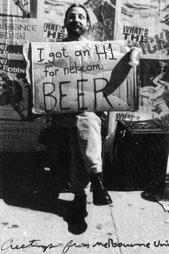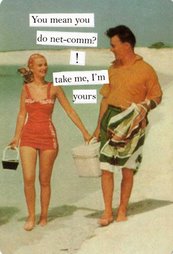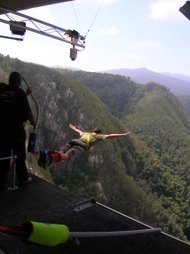"Net art is concerned with data, explored both in a formal sense, as an underpinning and organizational material, but also a socio-political concern in which artists raise issues of access, distribution and usage of information sets"
(Stallabrass, 2003: 26)
1.0 WHAT IS NET.ART?
Net.art is one tool deployed by online activists to critique, amongst other things, corporate and governmental intervention in the free flowingness of information on the web. What distinguishes this 'Net-war', and determines the efficacy of net.art as a weapon therein, is the post-industrial, post-territorial nature of the conflict, and the lack of static points of conflict; Net.art moves along rhizomal nodes of hypertext, targeting not so much it's direct enemies, but the human mind (Green, 2004: 120)
Though there are myriad artistic renditions of the code which underlies net.art, the medium-centric conception of net.art incorporates any design, digital image, code, thing which relies on internet technologies for its realization, content and dissemination (Corby, 2006: 2). Note here the irony of the locational import of net.art, in light of the pre-digitized art world's tendency to classify art as anything chosen by a curator for exhibition in a museum or gallery (Wands, 2006: 11).
Baumgaertel captures the unique reflexivity of net.art's socio-political critique, “Net art addresses its own medium; it deals with the specific conditions the internet offers. It explores the possibilities that arise from its taking place within this electronic network and is therefore “net specific”. It deals creatively with software and with the rules software follows in order to work. It only has any meaning at all within its medium, the Internet” (2002: 24) Jodi.Org's 'Yeeha' pictured below, is a particularly good example of this contextual dependence, since its semiotic meaning is derived from pure data, a file containing sequences of zeros and ones saved in digital storage media. (Greene, 2004: 74)...
Though there are myriad artistic renditions of the code which underlies net.art, the medium-centric conception of net.art incorporates any design, digital image, code, thing which relies on internet technologies for its realization, content and dissemination (Corby, 2006: 2). Note here the irony of the locational import of net.art, in light of the pre-digitized art world's tendency to classify art as anything chosen by a curator for exhibition in a museum or gallery (Wands, 2006: 11).
Baumgaertel captures the unique reflexivity of net.art's socio-political critique, “Net art addresses its own medium; it deals with the specific conditions the internet offers. It explores the possibilities that arise from its taking place within this electronic network and is therefore “net specific”. It deals creatively with software and with the rules software follows in order to work. It only has any meaning at all within its medium, the Internet” (2002: 24) Jodi.Org's 'Yeeha' pictured below, is a particularly good example of this contextual dependence, since its semiotic meaning is derived from pure data, a file containing sequences of zeros and ones saved in digital storage media. (Greene, 2004: 74)...

1.1 WHO ARE NET ARTISTS?
Defining who belongs to the 'net-artist' fraternity is problematic, and perhaps unnecessary in light of Walter Banjamin's critique of new reproductive technologies' attack on artistic authenticity. According to Benjamin (1969), "By making many reproductions it substitutes a plurality of copies for a unique existence...That which withers in the age of mechanical reproduction is the aura of the work of art"(marxists.org) Lévy, on the other hand, is more optimistic than Benjamin, refusing to see net.art's nebulous authorship, lack of temporal fixity, and aversion to totalization, as grounds precluding the presupposition of an author, or at least an inchoate group of collaborators (2001: Ch 9).
Authorized by Lévy to proceed then, and wary of the the online deluge of apolitical mainstream bloggers - particularly from 2004 onwards - 'net.artists' will be defined not so much by their socio-political agendas or artistic mediums, but by the symbiotic relationship between and convergence of the post-industrial inhabitants of the political left (Sardar, 1996: 143), and the nascent knowledge industry's cyber-bourgeoisie, Gouldner's technical intelligentsia (1979: 49) whose coding skills manifest the socio-political critique of radical politics in the digital arena.
1.2 SPATIO-TEMPORAL CONTEXT OF NET.ART's SOCIO-POLITICAL ACTIVISM
"The economic world we are leaving was one whose main sources of wealth were physical. The things we bought and sold were things, you could touch them, smell them kick their tires...In this new era, wealth is the product of knowledge, information has became the economy's primary raw material" (Stewart, 1997: 54)
Due to its omnipresence it is easy to forget that the internet as we know it has only been around since 1993. In that year its developers at CERN in Switzerland announced access to the World Wide Web would be totally free, and Mosaic, the first graphical web browser that could represent images embedded in text without the need to open multiple windows was released in the US. The internet's open-sourceness, and hypertextuality made it a powerful tool for corporations looking to stake their market claim in the burgeoning global economy, and also activists seeking to check the rise of these entities. Activists took to protesting online to resist corporate colonization of the web, targeting the immateriality and virus like nature of millennial socio-economies (Jordan, 2004:39). So then, the 15 or so years of net.art must be contextualized by reference to the primary socio-political issues of its lifespan.
On line hactivist group Critical Arts ensemble declared in 1994 that power had moved from static points that can be targeted, to a nomadic existence in virtuality (Jordan, 2004: 70). According to the collective, traditional protest which relied on physicality of blockage was obsolete since things of value to states and corporations had been transfered online, civil disobedience tactics had to be translated into the virtual world. One of the tools employed by these pioneering online activists was art, in particular the noise triggered by the jamming of information transfer between websites and browsers, which yielded an aesthetic of failure, representations of insufficiency and vulnerable corporeality (White, 2006: 113).
1.3 EXAMPLES OF NET.ART BASED HACKTIVIST CRITIQUE?
1.3.1 Anti-Globalisation - Floodnet (Electronic Disturbance Theatre)

"Instantaneous, simultaneous and on-demand information is the engine of creative destruction, and it is the destruction of this eternal now" (Lui, 2006: 9)
On January 1st 1994 the NAFTA came into operation, and in the Southernmost state of Mexico a group representing the Zapatista movement responded. Though the rebellion was quashed by the Mexican military the following year, in 1998, with the help of Electronic Disturbance Theatre, they became the first minority post-modern protest group. For such groups, net.art offers a non-violent alternative to resisting Schumpeter's critique of capitalist economies, under which they inevitably perish: "A perennial gale of creative destruction incessantly revolutionizes the economic structure from within, incessantly destroying the old one, incessantly creating a new one" (1942: 84)
1.3.2 Corporate colonization of the web - 'Dow Chemical says yes to Bhopal' (The Yes Men)
Green's argument is that the international finance market's reliance on unimpeded global information infrastructure justifies the adoption of 'new strategic objectives', "not obliteration, but manipulation, not destruction, but infiltration and assimilation" (2004: 120). Admittedly, such guerrilla tactics allowed the 'Yes Men' (pictured below) to assume the corporate identity of Dow Chemical by simply generating a spoof web site, which they then used to secure a BBC news interview. But the speciousness of the critique that strikes only at the corporation's brand/image before retreating was later illustrated by a market rally behind Dow Chemical and their unmoved retort, "Much as Dow may care as human beings about the victims of the catastrophe, we must reiterate that Dow's sole and unique responsibility is to its shareholders" (Corby, 2006: 181). So in the end, net.art's limit was the critique of the transparency of information on the web, and the blind faith placed in the universal validity of corporations.

1.3.3 War against 'terror' - Velvet Strike (Ann-Marie Schleiner)

Velvet strike critiques the Bush administrations' 'war on terror' by grafting anti-war images onto the virtual world of on-line shoot-em-up terrorism game Counter-Strike. User generated net.art was graffitied into the game carrying all kinds messages, in what was later dubbed graphic user intervention (GUI) - itself a parody of browsers' such as explorer (1995) graphic user interface.
1.4 NET.ART & CONVERGENCE CULTURE

"The elusive paradoxical laws of cool give the tribes of the cubicle their secret intra-culture amid corporate culture" (Lui, 2006: 179)
Among other things, the 'convergence culture' identified by Henry Jenkins addressed the paradoxical relationship being played out between the corporate consolidation of the mediascape, and the unprecedented empowerment of consumers to archive, share, and generate content (2004). What his formulation neglects is the banal purgatory knowledge workers find themselves in, part consumer - part producer, a post-industrial techno-literate class, critiquing to remain sane but appeasing to remain employed, the corporate system that has added the equivalent of an extra month of work per year from the late 60s to the mid 80s, and blurred the sense of a boundary between job and home. (Lui, 2006: 76) Lui's formulation of this inchoate group of itinerant corporate workers is modeled on Gouldner's technical intelligencia (Lui, 2006: 392).













